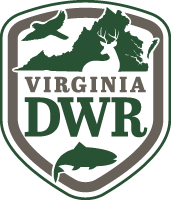Description
Elevation: 2184 ft.
Clinch Mountain Wildlife Management Area (WMA) is the largest and most biologically diverse WMA in Virginia. It encompasses 25,477 acres of mountain forest along Clinch Mountain, contains Laurel Bed Lake, and spans elevations from 2200 feet along Big Tumbling Creek to its highest point at 4700 feet on Beartown Mountain. The WMA possesses a variety of habitats, attractive to a diversity of wildlife. The naturalist can wander through mature-growth forests, predominantly wooded by oak and hickory, rhododendron thickets, beaver ponds, a lake, meadows, shrublands, managed forests and prescribed burns, and even red spruce forest atop Beartown Mountain. The woodlands hold typical eastern hardwood breeders, such as wood thrush, and eastern wood-pewee. As elevation increases, so does the assortment of nesting avian species within these woodlands. Visitors should look for black-throated blue, black-throated green, chestnut-sided, cerulean, and magnolia warblers. Also keep an eye out for blue-headed vireo, rose-breasted grosbeak, and veery. Birders may want to hike into an area called the Muck Cove. In the summer, the Muck can be particularly productive for birders in search of golden-winged warbler.
Laurel Bed Lake is another bird-watching highlight within Clinch Mountain Wildlife Management Area. At an elevation of 3674 feet, this manmade lake was created by the damming of Big Tumbling Creek. Migratory waterfowl and shorebirds can be found on this lake. Wood duck and pied-billed grebe have been known to breed here, but are not regular nesters. In the fall, bald eagle may be seen hunting over the lake. Great blue heron is an often-elusive resident. During the summer, an observant and diligent birder may find spotted or solitary sandpiper along lake edges. Intensive programs crafted by local management to ease nesting habits of tree swallow have resulted in the placement of numerous nest boxes around the lake. The surrounding woodlands can be accessed by trails, or well-traveled, worn footpaths of previous birders. These woodlands are excellent for finding migrant and nesting songbirds. Magnolia, black-throated blue, and black-throated green warblers can often be spied within the woodlands south of the upper boat ramp.
Throughout the WMA, herp-lovers will enjoy 24 species of reptiles and 30 species of amphibians, including green and four-toed salamanders. With a list of 51 mammal species, visitors are encouraged to keep an eye out for black bear, red fox, white-tailed deer, beaver, mink, southern flying squirrel, Appalachian and eastern cottontails, and big brown bats. This extensive area provides unlimited wildlife-watching potential.
Notes:
- To Access the Site: A Restore the Wild Membership, Virginia hunting license, freshwater fishing license, boat registration, or an access permit is required.
- This site may be closed during certain times of year for hunting or land management. See seasonal access information on the Clinch Mountain WMA website.
- If you are visiting this site during hunting seasons, please wear blaze orange/pink for safety.
Wildlife Sightings
Amenities & Access Considerations
Amenities
- Parking
- Restrooms
- Primitive Camping
Maps & Directions
Location: North of the town of Saltville, Virginia.
WMA Coordinates: 36.8973076757, -81.842506331
Laurel Bed Lake Coordinates: 36.953814, -81.812567
From I-81, take Rt. 107 from Chilhowie to Saltville. Turn left on Rt. 91, then right at traffic light on to Rt. 634. Go to Allison Gap, take a left on Rt. 613, then a right on to Rt. 747. Turn right in to the Clinch Mountain Wildlife Management Area. To continue towards Laurel Bed Lake, once in the WMA, continue on Rt. 747/Tumbling Creek Road for another 3.0 miles to the fork in the road. Veer left onto a wooden bridge and travel 2.2 miles to reach the road to the dam.
From the town of Saltville, turn left onto route 91 (0.25 mile); then right onto Route 634 and follow to Allison Gap, then left on Route 613 and proceed 3.5 miles; then right onto Route 747 and turn right into the Clinch Mountain Wildlife Management Area. To continue towards Laurel Bed Lake, once in the WMA, continue on Rt. 747/Tumbling Creek Road for another 3.0 miles to the fork in the road. Veer left onto a wooden bridge and travel 2.2 miles to reach the road to the dam.
What to Know Before Visiting
The Virginia Bird and Wildlife Trail is a network of more than 500 premier wildlife viewing sites across the state. Walk a nature trail, paddle a river, or enjoy a scenic overlook and you’ll soon understand what makes Virginia a premier destination for birding and wildlife viewing.

